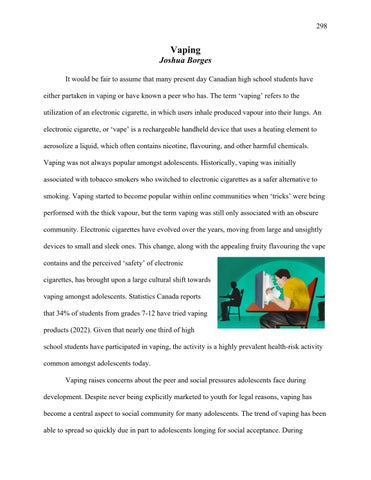298
Vaping Joshua Borges It would be fair to assume that many present day Canadian high school students have either partaken in vaping or have known a peer who has. The term ‘vaping’ refers to the utilization of an electronic cigarette, in which users inhale produced vapour into their lungs. An electronic cigarette, or ‘vape’ is a rechargeable handheld device that uses a heating element to aerosolize a liquid, which often contains nicotine, flavouring, and other harmful chemicals. Vaping was not always popular amongst adolescents. Historically, vaping was initially associated with tobacco smokers who switched to electronic cigarettes as a safer alternative to smoking. Vaping started to become popular within online communities when ‘tricks’ were being performed with the thick vapour, but the term vaping was still only associated with an obscure community. Electronic cigarettes have evolved over the years, moving from large and unsightly devices to small and sleek ones. This change, along with the appealing fruity flavouring the vape contains and the perceived ‘safety’ of electronic cigarettes, has brought upon a large cultural shift towards vaping amongst adolescents. Statistics Canada reports that 34% of students from grades 7-12 have tried vaping products (2022). Given that nearly one third of high school students have participated in vaping, the activity is a highly prevalent health-risk activity common amongst adolescents today. Vaping raises concerns about the peer and social pressures adolescents face during development. Despite never being explicitly marketed to youth for legal reasons, vaping has become a central aspect to social community for many adolescents. The trend of vaping has been able to spread so quickly due in part to adolescents longing for social acceptance. During
